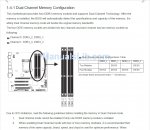My machine is in a sorry state at the moment and I could use some help in working out a logical approach to finding out what is wrong.
I came home on Friday to be told by my son that the PC had been asking for a system disk, but when I started it up everything appeared to be working as normal and I got a couple of hours use before stopping for the evening. Yesterday he tried using it again and this time I saw the system disk request and watching it boot up, could see the primary SSD was showing a SMART error. I checked connections and then ended up with the system failing to recognise anything in that port.
Next job was to swap some disks around and that led to the alternative drive not being recognised by the BIOS. The machine couldn't boot in to Windows though... it showed me the swinging balls under the Windows 10 logo for ages before eventually powering down. I don't know if that was because it was trying to boot to a drive that wasn't attached to its normal port on the motherboard.
Trying again this morning, everything is very slow. It takes the BIOS thirty second or more to identify the disks (SSD x 2, HDD, DVD). I got as far as a Windows self diagnosis that doesn't tell you what it's trying to do and on a reboot it let me log in to Windows, but only to a black screen. It has been powering down for about ten minutes (blue screen with swinging balls).
I had initially thought it was the SSD failing, but now it feels more like a motherboard issue. I don't understand why everything is now going so slowly and if that tells me anything.
I think the next job is to connect only the primary SSD and see if that helps narrow down what's causing the problem. If I can get in to Windows, are there any particular diagnosis tools I should use?
Any other thoughts about what I should look in to?
I came home on Friday to be told by my son that the PC had been asking for a system disk, but when I started it up everything appeared to be working as normal and I got a couple of hours use before stopping for the evening. Yesterday he tried using it again and this time I saw the system disk request and watching it boot up, could see the primary SSD was showing a SMART error. I checked connections and then ended up with the system failing to recognise anything in that port.
Next job was to swap some disks around and that led to the alternative drive not being recognised by the BIOS. The machine couldn't boot in to Windows though... it showed me the swinging balls under the Windows 10 logo for ages before eventually powering down. I don't know if that was because it was trying to boot to a drive that wasn't attached to its normal port on the motherboard.
Trying again this morning, everything is very slow. It takes the BIOS thirty second or more to identify the disks (SSD x 2, HDD, DVD). I got as far as a Windows self diagnosis that doesn't tell you what it's trying to do and on a reboot it let me log in to Windows, but only to a black screen. It has been powering down for about ten minutes (blue screen with swinging balls).
I had initially thought it was the SSD failing, but now it feels more like a motherboard issue. I don't understand why everything is now going so slowly and if that tells me anything.
I think the next job is to connect only the primary SSD and see if that helps narrow down what's causing the problem. If I can get in to Windows, are there any particular diagnosis tools I should use?
Any other thoughts about what I should look in to?

